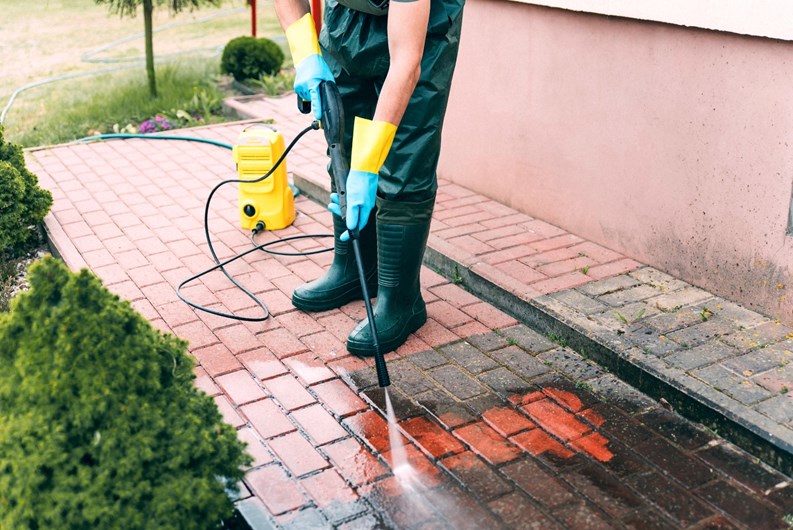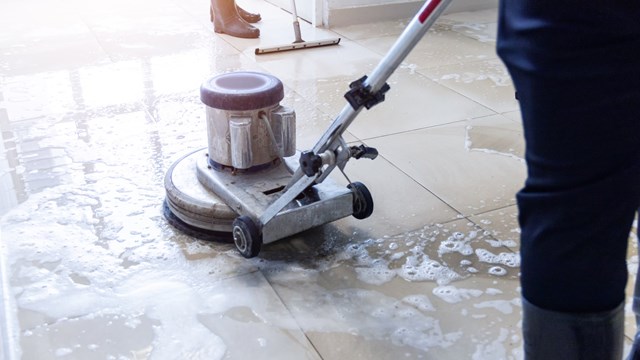It’s that time of year again. Birds are chirping; trees are blooming; property managers and co-op and condo boards are addressing their task lists for the change of seasons. Whether it’s a Wrigleyville walk-up or a Streeterville supertall, a dense city development or a sprawling suburban complex, a building up north still shoveling snow or a southern community whose pool is open year-round, spring is the time to give every property a little sprucing up.
Early Bird vs. Worm
According to the pros, winter’s short, dark days are the perfect time to get a jump on spring planning. Well in advance of the first robin’s appearance, checklists should be in order, vendors and suppliers contacted and scheduled, and staff and board members prepared so that everything comes up roses—or tulips—when the weather starts to warm.
“Doing the prep work now can possibly save you money in the end,” says Alan Bressler, Chairman of the Board & Chief Operating Officer of Guardian Services in New York, which provides a range of facility services to buildings and communities throughout the Northeast, New England, and the Mid-Atlantic. “Getting all your key stakeholders involved early can really improve your facility maintenance operation.”
Brian Butler, CMCA, CAM, PCAM, senior vice president—high rise at FirstService Residential Illinois, agrees. “The best thing that a board can do to prepare for the spring is to fight the urge to defer reviewing details or making decisions related to upcoming capital repair needs,” he says. “If boards wait until the spring thaw comes to begin making decisions and hiring contractors, they’ll often find that the schedules for the work are tighter, and pricing may be higher than if they had made those decisions during the fall or winter months.”
Neil Betoff, president of STAR Building Services in Shrewsbury, New Jersey, says that his company was already largely booked up by April. “[Late February] is the perfect time to do your spring cleaning walk through, in large part because you want to get on the vendor’s work schedule,” he advises.
And Scott Dalley, a real estate management consultant based in Maine, suggests boards start preparing for the upcoming season six months in advance. “If you wait until springtime to engage with landscaping vendors, or to consider an improvement project on your grounds, then you will be way behind the eight ball,” he says. “You may sacrifice both value and quality of work. For a big planting project, for example, you want to be starting a year in advance, as you may want to get materials in the ground, depending on the nature of the work. A landscaping project undertaken in the fall can literally bear fruit, or at least the desired effect of your planning, when the spring arrives.”
Safety & Structure
First and foremost, a building and its surrounding property should be visually inspected for anything that could affect safety or structural integrity. Bressler suggests choosing a starting point—either the roof or the cellar—and working through to the other end thoroughly and methodically. “Check pipes, fittings, structure, seals, and so forth for any damage, leaks, cracks, et cetera, and notify any vendors you may need with your repair lists,” he says. “While you are conducting your inspections and soft starts”—the preliminary tests of equipment that has been dormant over the winter, like air conditioners or pool pumps—“make spot repairs as you go along. If existing staff cannot handle it, contact your vendors now, before they get very busy and you will have to wait. Prioritize your projects and set them on a timeline. This will allow you to go back to one central location to check them off as completed.”
Betoff says that the often-harsh New Jersey winters are especially rough on sidewalks and pavement, so managers and supers should pay particular attention to these surfaces as they conduct their walk-throughs. “Look for cracking and problems with sidewalks, parking-lot alligatoring [a condition where a series of cracks appear in one area of pavement that often intersect and crisscross in a scaly pattern], potholes, and damaged curbs from snow removal plows,” he says. “Now is the time to fix those. Also look for cracks on the building exterior—rain or melting snow can settle into the cracks and then, at night when it freezes, it expands.” He goes on to say that mortar, caulking, and sealants should all be inspected for cracks.
Speaking of harsh winters, Chicago’s residential buildings get a substantial amount of damage from snow and ice during the gnarly cold months—but roofs are particularly vulnerable, says Butler. He explains that snow on a roof will start to melt from the heat of the building, but then freeze again as it moves outward, causing ice ridges to form at the roof’s edge. Known as “ice damming,” this condition causes the melting snow to pool and prevents it from draining, leading to leaks and other problems when the weather starts to warm.
The experts agree that roofs are an example of an area where specialists should be engaged for inspections and repairs. The distance from the ground is only one consideration. Using an under-qualified worker for such a task isn’t just dangerous for the worker; it can void warranties, leave problems overlooked (leading to more costly repairs), and even raise issues of liability. Since “winter ice damming can be especially damaging to roofs,” warns Butler, “an association should engage a roofing expert to conduct regular inspections to better identify necessary repairs to avoid further water infiltration when the spring arrives in force.”
Beautification
Whatever kind of weather Old Man Winter has brought to a particular location, by March or April, there is some clean-up to be done. Wind, precipitation, freeze-thaw cycles, and products used to mitigate these elements like salt, sand, and burlap have left a mess—and that mess has been dragged through lobbies, elevators, hallways, and other common spaces of residential buildings for the last few months. Downed branches, leaves, and other debris need to be removed from flower beds, awnings, tree pits, and roofs. Sidewalks and asphalt have taken a beating, while pool decks and playgrounds have gathered dust.
To welcome the change of season—as well as residents returning from winter abodes or prospective purchasers using the fair weather to conduct their home search—it is a good time to do some “detailing”; washing windows, pruning bushes and trees, cleaning light fixtures and globes, repainting, and freshening lobby plants and art will go a long way toward letting the light of spring into a building.
While some of this clean-up can be handled by a property’s maintenance staff—or even a group of homeowners or shareholders such as a grounds committee—others require specific expertise or credentials. No matter what is on the checklist or who is performing the job, the best advice is to follow the Scout motto: Be Prepared.
“Spring is usually busy for people moving in and out of properties,” Butler notes, “so association staff should prepare heavily trafficked service areas by installing fresh corner guards and ensuring that elevator pads are in good condition to better protect the cabs. These steps can save thousands of dollars in repairs after the moving season is over.”
He also adds that “the rain that comes with spring can often result in wet lobbies with slippery conditions,” so “in-house staff should replace worn lobby floor mats, inspect seals around common area windows and doors, and confirm that building drainage systems are free of debris or blockages.”
Betoff adds vents and ducts to the cleaning list—another task that should be left to the professionals—and includes signs and stanchions as elements that should be inspected for wear and function and repaired or replaced if necessary. “Everybody has a choice where they are going to live,” says Betoff. “People buy when they like what they see.”
He also mentions maintenance on pools and the pool equipment, as well as the furniture and planters that may surround them. “Examine the pool furniture, because now is a perfect time to repair it and get replacements if you need them,” says Betoff. “If you order any parts you need now, they will be here in time for the opening of the pool.”
Dalley agrees, adding tennis courts to the checklist: “If you’re going to do something like resurfacing a tennis court, your window of opportunity is certainly limited, as that is a weather-sensitive project. You want to schedule that repair as soon as you can, as people are going to want to play as soon as the weather turns. If you can do it late in the fall, so much the better—but if you have to do it in the spring, you want to make sure that you’re on the vendor’s calendar so they can do it right away and you maximize the value to your homeowners.”
Bressler adds to the tally. “If your building has awnings,” he notes, “check to make sure they made it through the season. Check all your fittings and standpipes. Now is also a good time to start pressure washing and painting areas that need touching up.” This includes lobbies, corridors, trash rooms, and amenity spaces. “Salt, slush, ice, and dirt have been pounded into your floors for the last two or three months. Schedule them for a deep cleaning. Inspect your floor mats and replace any that have outlived their usefulness. Strip and wax, shampoo—do what you have to do—but get those floors cleaned,” he urges.
Behind the Scenes
Spring is also a time for other types of “housekeeping” that are not necessarily part of an association’s or corporation’s physical plant, but should be included on that annual checklist, say the pros. These include:
• Inventory—Make sure you have an ample supply of inventory and make note of what has been depleted over the winter months so you can reorder.
• Fire safety—Have all fire safety equipment cleaned and serviced; send notices to residents about changing batteries in fire and smoke alarms.
• Audit—These are the months that third-party accountants conduct annual financial audits and tax returns. Schedule a shareholder or unit-owner informational meeting to report on the co-op’s or condo’s financial position.
• Archive—Gather all of your financial statements, deposit slips, and paid bills for the previous year, whether in physical or electronic form, and file them accordingly. This will make the aforementioned audit process smoother and quicker, too.
• Disaster preparedness—Communicate to residents the building’s or community’s plans in the event of a natural disaster or other type of emergency. Check any updates to municipal preparedness guidelines; ensure insurance and broker information is up to date; and register staff and board members as responders if appropriate.
• Homeowner/shareholder reminders—Send a newsletter or notice to unit owners/shareholders reminding them to declutter balconies and terraces, clean up pet waste that wasn’t picked up over the winter, have air conditioning units installed properly, and any other limited-common-element upkeep that is their responsibility.
Darcey Gerstein is Associate Editor and a Staff Writer for CooperatorNews.










Leave a Comment